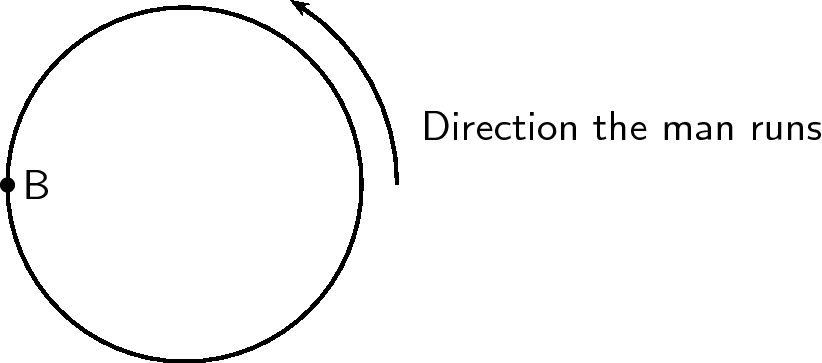| << Chapter < Page | Chapter >> Page > |
(Average) Speed (symbol ) is the distance travelled ( ) divided by the time taken ( ) for the journey. Distance and time are scalars and therefore speed will also be a scalar. Speed is calculated as follows:
Instantaneous speed is the magnitude of instantaneous velocity. It has the same value, but no direction.
James walks 2 km away from home in 30 minutes. He then turns around and walks back home along the same path, also in 30 minutes. Calculate James' average speed and average velocity.

The question explicitly gives
The information is not in SI units and must therefore be converted.
To convert km to m, we know that:
Similarly, to convert 30 minutes to seconds,
James started at home and returned home, so his displacement is 0 m.
James walked a total distance of 4 000 m (2 000 m out and 2 000 m back).
James took 1 800 s to walk out and 1 800 s to walk back.
A man runs around a circular track of radius . It takes him to complete a revolution of the track. If he runs at constant speed, calculate:

To determine the man's speed we need to know the distance he travels and how long it takes. We know it takes 120 s to complete one revolution ofthe track.(A revolution is to go around the track once.)
What distance is one revolution of the track? We know the track is a circle and we know its radius, so we can determinethe distance around the circle. We start with the equation for the circumference of a circle
Therefore, the distance the man covers in one revolution is .
We know that speed is distance covered per unit time. So if we divide the distance covered by the time it took we will know how much distance was covered for every unit of time. No direction is used here because speed is a scalar.
Consider the point A in the diagram.
We know which way the man is running around the track and we know hisspeed. His velocity at point A will be his speed (the magnitude of the
velocity) plus his direction of motion (the direction of hisvelocity).
The instant that he arrives at A he is moving as indicated in thediagram.
His velocity will be
West.


Consider the point B in the diagram.
We know which way the man is running around the track and we know hisspeed. His velocity at point B will be his speed (the magnitude of the
velocity) plus his direction of motion (the direction of hisvelocity). The instant that he arrives at B he is moving as indicated in
the diagram.His velocity will be
South.


To determine the average velocity between A and B, we need the change in displacement between A and B and the change in time between A and B. Thedisplacement from A and B can be calculated by using the Theorem of Pythagoras:

Triangle AOB is isosceles and therefore angle BAO = 45 .
The direction is between west and south and is therefore southwest.
The final answer is: , southwest.
Because he runs at a constant rate, we know that his speed anywhere around the track will be the same. His average speed is .
To calculate average velocity we need his total displacement and his total time. His displacement is zero because he ends up where he started. Histime is . Using these we can calculate his average velocity:

Notification Switch
Would you like to follow the 'Physics - grade 10 [caps 2011]' conversation and receive update notifications?